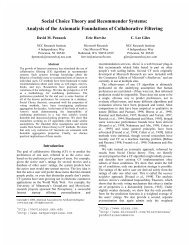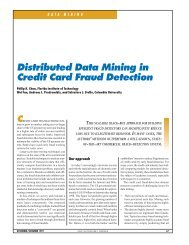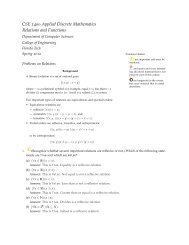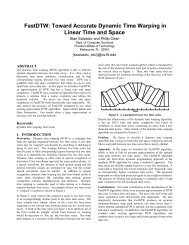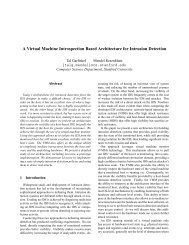Distributed objects and remote invocation
Distributed objects and remote invocation
Distributed objects and remote invocation
Create successful ePaper yourself
Turn your PDF publications into a flip-book with our unique Google optimized e-Paper software.
Java RMI (4): client of ShapeList<br />
Java RMI (5): Java RMIregistry (port 1099)<br />
import java.rmi.*;<br />
import java.rmi.server.*;<br />
import java.util.Vector;<br />
public class ShapeListClient{<br />
public static void main(String args[]){<br />
System.setSecurityManager(new RMISecurityManager());<br />
ShapeList aShapeList = null;<br />
try{<br />
aShapeList = (ShapeList) Naming.lookup("//bruno.ShapeList") ; 1<br />
Vector sList = aShapeList.allShapes(); 2<br />
} catch(RemoteException e) {System.out.println(e.getMessage());<br />
}catch(Exception e) {System.out.println("Client: " + e.getMessage());}<br />
}<br />
}<br />
void rebind (String name, Remote obj)<br />
This method is used by a server to register the identifier of a <strong>remote</strong> object by<br />
name, as shown in Figure 15.13, line 3.<br />
void bind (String name, Remote obj)<br />
This method can alternatively be used by a server to register a <strong>remote</strong> object<br />
by name, but if the name is already bound to a <strong>remote</strong> object reference an<br />
exception is thrown.<br />
void unbind (String name, Remote obj)<br />
This method removes a binding.<br />
Remote lookup(String name)<br />
This method is used by clients to look up a <strong>remote</strong> object by name, as shown<br />
in Figure 15.15 line 1. A <strong>remote</strong> object reference is returned.<br />
String [] list()<br />
This method returns an array of Strings containing the names bound in the<br />
registry.<br />
Instructor’s Guide for Coulouris, Dollimore <strong>and</strong> Kindberg <strong>Distributed</strong> Systems: Concepts <strong>and</strong> Design Edn. 4<br />
© Pearson Education 2005<br />
Instructor’s Guide for Coulouris, Dollimore <strong>and</strong> Kindberg <strong>Distributed</strong> Systems: Concepts <strong>and</strong> Design Edn. 4<br />
© Pearson Education 2005<br />
Java RMI (6):<br />
Events <strong>and</strong> notifications (1):<br />
Callbacks<br />
server notifying the clients of events<br />
⌧Initiated by server [opposite to initiated by client]<br />
why?<br />
⌧polling from clients increases overhead on server<br />
⌧not up-to-date for clients to inform users<br />
how<br />
⌧<strong>remote</strong> object (callback object) on client for server to call<br />
⌧client tells the server about the callback object, server put the client on a<br />
list<br />
⌧server call methods on the callback object when events occur<br />
client might forget to remove itself from the list<br />
⌧lease--client expire<br />
events of changes/updates...<br />
notifications of events to parties interested in the events<br />
publish events to send<br />
subscribe events to receive<br />
main characteristics in distributed event-based systems:<br />
a way to st<strong>and</strong>ardize communication in heterogeneous systems (not<br />
designed to communicate directly)<br />
asynchronous communication (no need for a publisher to wait for each<br />
subscriber--subscribers come <strong>and</strong> go)<br />
event types<br />
each type has attributes (information in it)<br />
subscription filtering: focus on certain values in the attributes (e.g.<br />
"buy" events, but only "buy car" events)<br />
Instructor’s Guide for Coulouris, Dollimore <strong>and</strong> Kindberg <strong>Distributed</strong> Systems: Concepts <strong>and</strong> Design Edn. 4<br />
© Pearson Education 2005<br />
Instructor’s Guide for Coulouris, Dollimore <strong>and</strong> Kindberg <strong>Distributed</strong> Systems: Concepts <strong>and</strong> Design Edn. 4<br />
© Pearson Education 2005<br />
Events <strong>and</strong> Notifications (2): [subscribers: dealers in<br />
stock exchange]<br />
Events <strong>and</strong> notifications (3):<br />
Dealer’s computer<br />
Dealer<br />
Dealer’s computer<br />
Dealer<br />
Notification<br />
Notification<br />
Notification<br />
Notification<br />
Notification<br />
Information<br />
provider<br />
External<br />
source<br />
Information<br />
provider<br />
External<br />
source<br />
Notification<br />
Notification<br />
Notification<br />
Notification<br />
Notification<br />
Dealer’s computer<br />
Dealer<br />
Dealer’s computer<br />
Dealer<br />
<strong>Distributed</strong> event notification<br />
decouple publishers from subscribers via an event service (manager)<br />
Architecture:<br />
object of interest (usually changes in states, e.g. temperature, price)<br />
event<br />
notification<br />
subscriber<br />
observer object (proxy) [reduce work on the object of interest]<br />
⌧forwarding<br />
⌧filtering of events types <strong>and</strong> content/attributes<br />
⌧patterns of events (occurrence of multiple events, not just one) [e.g. drop in<br />
temperature for more than five degrees three times in a row]<br />
⌧mailboxes (notifications in batches, subscriber might not be ready)<br />
publisher (object of interest or observer object)<br />
⌧generates event notifications<br />
Instructor’s Guide for Coulouris, Dollimore <strong>and</strong> Kindberg <strong>Distributed</strong> Systems: Concepts <strong>and</strong> Design Edn. 4<br />
© Pearson Education 2005<br />
Instructor’s Guide for Coulouris, Dollimore <strong>and</strong> Kindberg <strong>Distributed</strong> Systems: Concepts <strong>and</strong> Design Edn. 4<br />
© Pearson Education 2005<br />
6


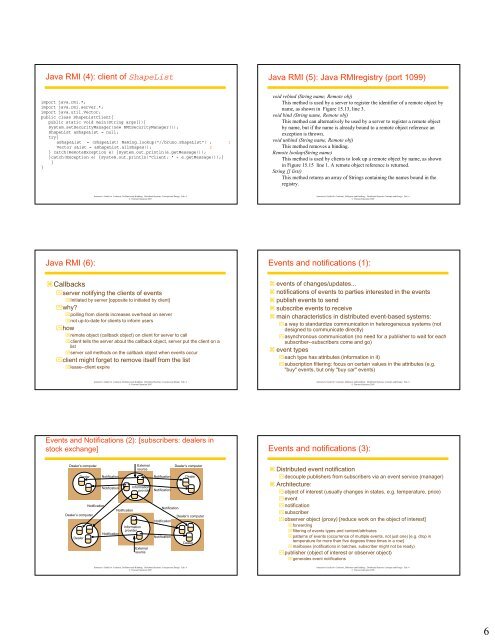
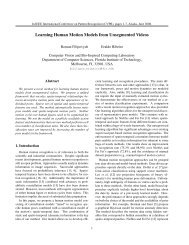
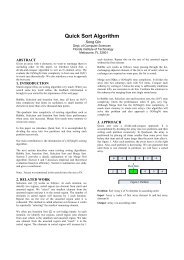
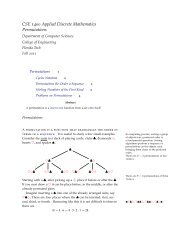
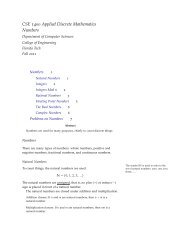
![{ public static void main (String[] args) { System.out.println (](https://img.yumpu.com/49719541/1/190x143/-public-static-void-main-string-args-systemoutprintln-hello-.jpg?quality=85)
